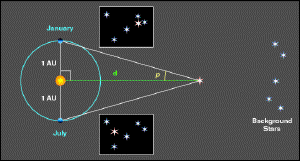Blog
Perception of Depth
31 August 2013
If you’ve ever watched a 3D movie, you’ve noticed how the image on the screen appears to have a certain depth to it. Certain objects just seem farther away. Other objects (usually pointy things) seem to leap out from the screen. You’ve also probably noticed that you have to wear a pair of glasses to watch the movie. If you take the glasses off during the movie, things look somewhat blurry.
3D movies work by projecting two movies at the same time. The two movies are almost identical, except that one was filmed (or computer generated) slightly to the left of center, and the other was filmed slightly to the right. This means that each movie has a slightly different point of view. The movies are projected on a special screen such that the light reflected from right projector is polarized one way, and the light from the left projector is polarized another. The glasses you wear are polarizing filters, and they ensure that only the left image reaches your left eye and only the right image reaches your right eye. With the glasses on, you see a different point of view in each eye. When you take the glasses off, you see both images at once, which is why they look blurry.
This trick works because (most) humans have depth perception. Our brains are able to integrate these two points of view into a perception of near and far. The same effect exists in the real world, and helps us do things like catch baseballs (or duck for the less athletically inclined). But the effect is typically more dramatic in the theater.
Depth perception is possible because a closer object exhibits a parallax shift when compared to more distant object. You can see this effect by looking at a a distant object. Close one eye, and hold up your thumb to cover the distant object. Without moving your thumb, switch eyes. What you will see is that your thumb has shifted because of the different point of view. If you hold your thumb closer to your face you get a bigger shift. Farther away and you get a smaller shift. This relationship is true in general. The closer the object the bigger the parallax shift. So by observing the parallax of objects, your brain can gauge their distance.
 University of Virginia
University of VirginiaWe can use the same effect to measure the distances of stars, using the width of Earth’s orbit. As the Earth moves around the Sun, you can measure the apparent position of a star against more distant stars. Over time you can observe the shift when the Earth is at one side of its orbit, and when its at the other side. That gives us two points of view separated by about 186 million miles (the actual distance varies depending on direction of the star in relation to Earth). This seems like a huge distance to us, but the parallax shift of stars is very small. Even the closest stars (not counting the Sun) are about 1 parsec away (a bit less than 4 light-years), which means they have a parallax shift of about 1 second of arc.
We’ve been able to use this cosmic depth perception to measure stellar distances up to about 1500 light years. Beyond that and the parallax shift is too small to measure accurately. Of course that raises the question of how we measure distances of farther objects. How can we say something is millions of light years away, or billions? For that we need several other methods, which together are known as the cosmic distance ladder.
But that’s a story for another time.